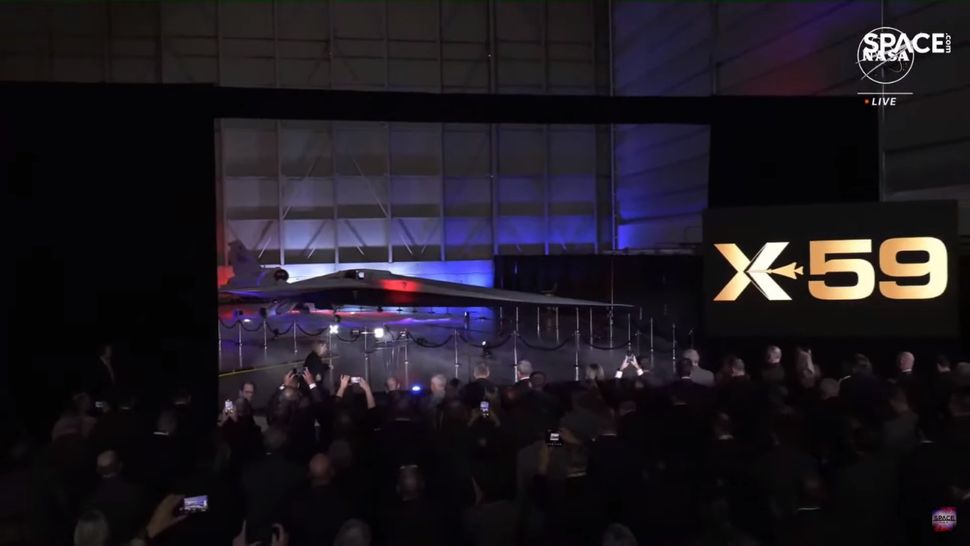The X-59 is finally here.
As NASA’s newest X-plane, the X-59 is designed to break the sound barrier without the thunderous sonic booms that typically occur when aircraft go supersonic. Instead, the Quesst will make a much quieter “thump,” similar to the sound of a car door slamming as heard from indoors. If successful, the jet has the potential to revolutionize supersonic flight and aviation in general.
After years of development, NASA and Lockheed Martin showed off the finished X-59 Quesst (“Quiet SuperSonic Technology”) today (Jan. 12) in front of a crowd of nearly 150 at the legendary Lockheed Martin Skunk Works facility in Palmdale, California, a research and development site typically known for its secrecy.
In Photos: Amazing X-Planes from the X-1 to XV-15

“It’s rare that we have the opportunity to host this many visitors at the Skunk Works, and it’s even more rare that we were able to publicly unveil one of our aircraft,” said John Clark, vice president and general manager of Lockheed Martin Skunk Works.
When the curtain finally fell to reveal the X-59, the assembled crowd applauded and held their mobile phones aloft to capture photos of the new jet, shining red and blue under stage lights. The elongated beak-like nose section of the aircraft stood out prominently, showing off the fact that it does not have a forward-facing window.
“This is a moment, future generations will look back upon with both awe and admiration,” said Greg Ulmer, Lockheed Martin’s Vice President of aeronautics. “The Skunk Works mantra of quick, quiet, and quality takes on a whole new meaning. As we usher in the hopes of a new era of quiet supersonic travel, made possible through our collaboration with NASA.”
In Photos: Chuck Yeager: First Person to Break the Sound Barrier
During the unveiling ceremony, NASA Deputy Administrator Pam Melroy underscored the agency’s long history of pioneering groundbreaking aviation developments.
“The first A in NASA stands for aeronautics. And we’re all about groundbreaking aerospace innovation,” Melroy said. “The X-59 proudly continues this legacy, representing the forefront of technology driving aviation forward.”
NASA’s latest X-plane (‘X’ for “experimental”) is the culmination of decades of research and involved radically different manufacturing approaches including new augmented reality systems, robotic drilling and 3D modeling techniques.
“This isn’t just an airplane, this is an X-plane,” Melroy added. “It’s the manifestation of a collaborative genius.”
But Melroy admitted that she had initial some doubts about the revolutionary aircraft. “As a test pilot, the first time I looked at the design I went ‘hmm,’ really had some questions about that.”
In particular, Melroy was referring to the fact that the X-59 does not have a forward-facing window, a design choice that helps reduce the sonic boom the aircraft produces. Instead, it features what NASA calls the eXternal Vision System, or XVS, which consists of a camera and a cockpit-mounted screen that offers pilots an augmented-reality view of what’s in front of the jet.
Melroy said this system has the potential to revolutionize aircraft design.
“We haven’t felt comfortable about putting in a crewed flight vehicle without first testing it. So this groundbreaking technology is really a beacon guiding us towards a future where visibility barriers in aircraft design can be overcome with this inventive solution.”
NASA leadership used the unveiling to underscore the roles that both the agency and the Southern California area have played in the rich American history of pushing aeronautics boundaries. “This journey actually began in 1947 when the era of supersonic flight started right here in the California high desert with test pilot Chuck Yeager and the X-1,” said NASA’s Associate Administrator for the agency’s Aeronautics Research Mission Directorate Robert Pearce.
Jim Free, NASA’s associate administrator, continued this sentiment, noting that the X-59 is merely the latest in a long line of NASA X-planes that have revolutionized aviation throughout the agency’s history.
“Even among other X-planes, the X-59 is special. Every aircraft that receives that X-plane designation has a specific purpose to test new technologies or aerodynamic concepts,” Free said, “These special planes push the envelope of what’s possible in flight. And once they prove those concepts, they often go into museums. And that’s really what makes the X-59 different.”
Free was referring to the fact that once the X-59 is ready for flight, the jet will make multiple flights over select residential areas in the United States in order to collect data on how people on the ground below experience and react to the quieter sonic booms it creates.
NASA will then use that data to seek approval for commercial supersonic flights from regulatory agencies such as the Federal Aviation Administration, with the ultimate goal of making aviation more sustainable and enabling faster flight over populated areas.
“The X-59 represents a nearly 100-foot long step forward in the journey of discovery that began began decades ago, a step toward opening the door to sustainable commercial supersonic flight over land,” Pearce added.
Some of the applications of supersonic flight mentioned at today’s unveiling include rapid medical response, shorter shipping times and, of course, faster travel.
NASA and Lockheed Martin aren’t the only ones pursuing commercial flight at speeds above the sound barrier. Colorado-based Boom Supersonic is developing a commercial supersonic passenger jet, the XB-1, which the company hopes to have in the air on its first flight in 2027.